Codling Moth Eradication Part 3: War of Attrition
Goal: KILL LARVAE IN COCOONS PLACED ON TREE TRUNKS
Method 1: Tree Trunk Wrap
5-13-23
Earlier attempts to eradicate trunk-laid cocoons involved cutting up old carboard boxes and painstakingly affixing them to the tree trunks. The idea is to create nooks and crannies for moths to spin cocoons in and then remove and destroy them a month later.
But they get wet, are not neat and were generally a sub-par method I was not pleased with.
I’ve since graduated to purpose-made tree wrap.
It goes on neater than cardboard strips you make from an old box. You remove it and destroy it monthly, ostensibly taking all cocoons to the burn pit with it.
The wrap protects the bark from becoming a nursery for cocoons and stops subsequent generations from gaining a foothold.
It is pleasing to look at if you are patient while you wrap and do a good job. Neutral in color, it also repels water and sticks to itself enough to make tucking in the tail no big deal. Note: order way more than you think you need.
But it didn’t work worth a damn.
Goal: DETERMINE IF MOTHS ARE FLYING AND BREEDING
Method 2: Tent Traps Baited with Pheromones
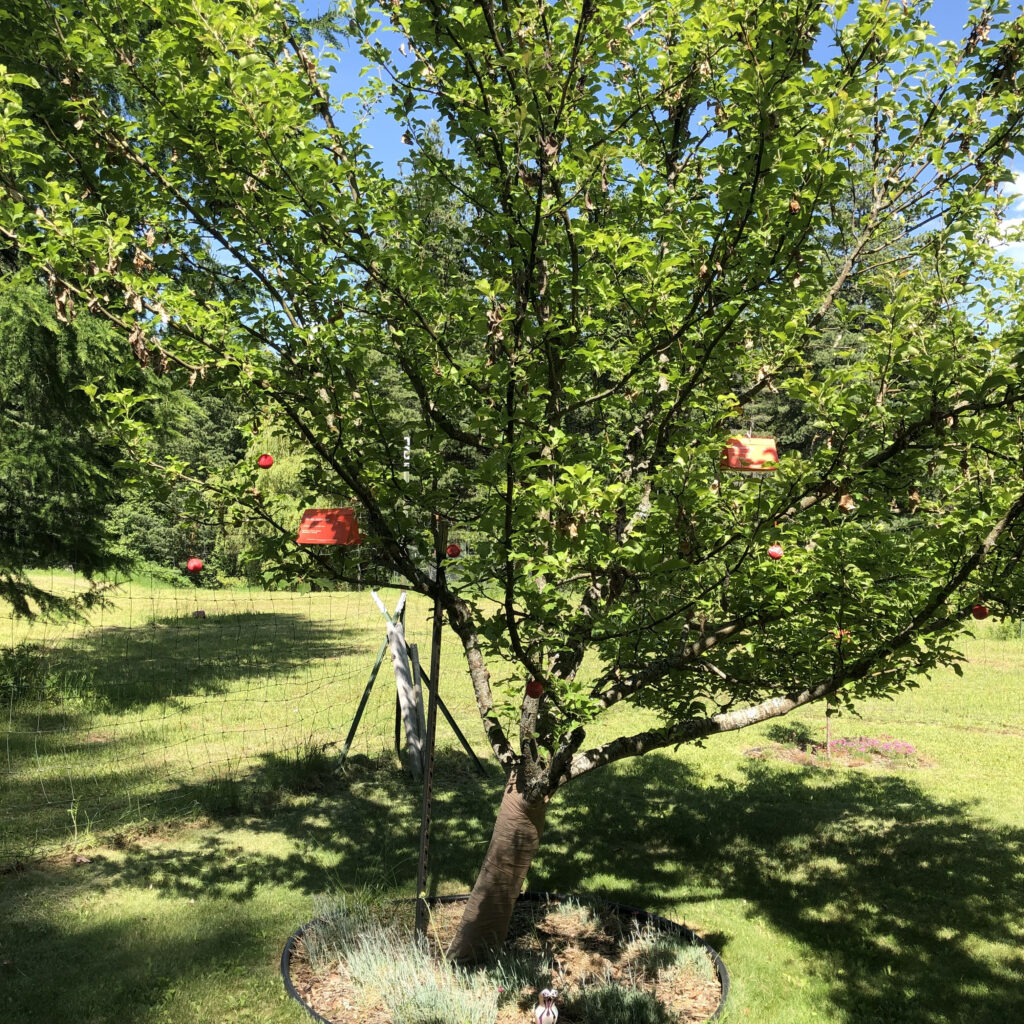
I hung Delta glue traps last year but did so without knowing much. Then I felt really bad when they were indiscriminate and caught insects I didn’t mean to kill. Terrible.
Now I know I need to hang the right traps at a certain time (as soon as trees bloom) and use the right lures.
The grid printed on the inside is there so you can scientifically determine how many codling moths you are dealing with, or at least the magnitude of your infestation.
And I’ve since learned that you need to hang glue traps baited with pheromone lures, expensive little rubber nipples impregnated with chemicals that are irresistible to both male and female codling moths.
But not to mason bees, bumble bees or any other Do-Gooders.
You can buy lures that attract only males or only females but at $40 a pop I opted for the non-gender discriminate lures that catch them all. I’m an equal opportunity codling moth killer. And is there anything better than this line from the ad copy? “This Lure Does Not Discriminate – It Works On Both Male & Female Codling Moths!” Try to ignore weird initial caps, but still . . .
Yes, you’ve probably got a shitload of codling moths if you have one, but these traps are key to establishing that yes, they are now flying and breeding and fixin’ to ruin your apples. The combo of the traps and pheromones allows you to strike them at the right time.
Putting them together is actually something you want to do when you are patient and wiling to wire up tiny lures into your traps, so they hang free and create optimum temptation for moths. Doing this is not easy and you will end up with sticky stuff all the way to your elbows. Just plan to roll in flour later so you don’t stick to your bedsheets.
If you want pointers setting up lures, I will be glad to show you. Mostly it is just patience and finesse.
Again with the Timing
When do you get the traps out and set? Good question! And the answer is — of course, in keeping with organic gardening tradition — “it depends.”
You need to set traps after the flowers bloom and when the fruit is setting.
At 62 degrees overnight, they fly and mate as moths — and all the action starts. Get them before this! I can’t stress this enough.
You are trying to kill their larvae — the creatures in the cocoons which have overwintered on the bark of your trees.
Once they become flying insects, their sole purpose is to lay more eggs which turn into voracious caterpillars (larvae), which then turn into moths which then . . . ad infimum, you get the idea.
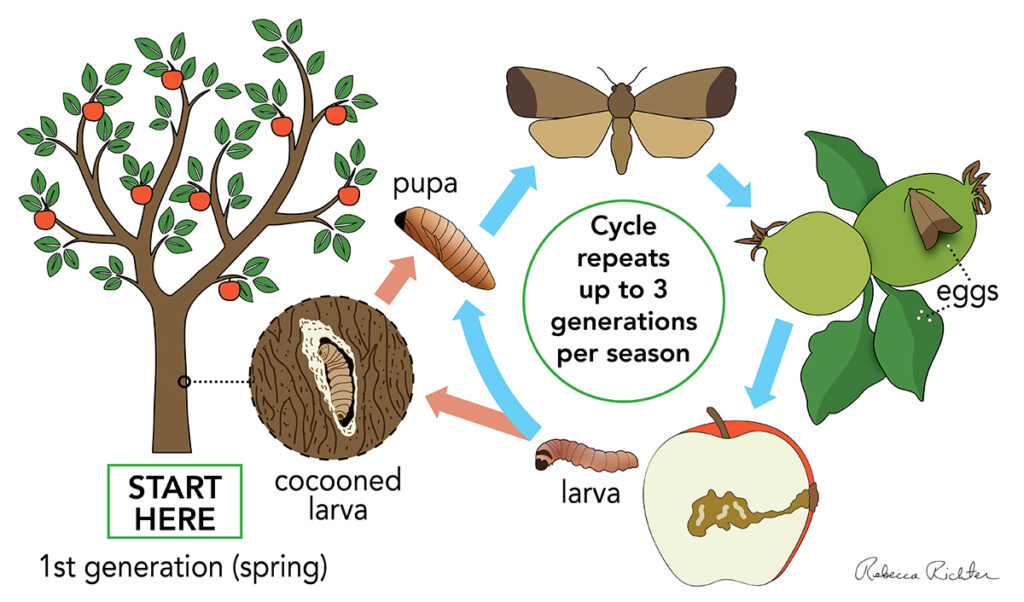
The Witching Hour
62 degrees at night happens pretty late here in Sandpoint. The time after fruit sets is still pretty cool. June 9 traps were set, nematodes applied. All was well.
On May 18 after all my fruit trees were in bloom, I put pheromones in the traps. And in mid-May we weirdly we had a super-hot spell that made no sense — and also turned out to be a huge ‘aha’ moment for me.
I caught three codling moths in my traps.
After I was done with my victory laps, I realized that the hot spell had allowed the temperature to reach 60+ for a few days. Before this, I had never laid eyes on codling moths before. Why, with such an infestation?
Well, interestingly, they only fly at dawn and dusk, times mosquitoes are also overwhelming and when I make myself scarce.
It was strangely gratifying to see those tiny moths stopped in their tracks in my traps. But I knew hateful larvae were waiting in little cocoons in the bark beneath my apple and pear trees for their next gluttonous spree.
Goal: KILL MOTHS TRYING TO LAY EGGS
Experimental Method: Hang False “Apples” and Trap and Kill Breeding Moths (The Bait and Switch)
I bought a bunch of red foam balls online and strung them with an upholstery needle and some nylon twine. Then I hung them in my apple trees and covered them with spray Tanglefoot.
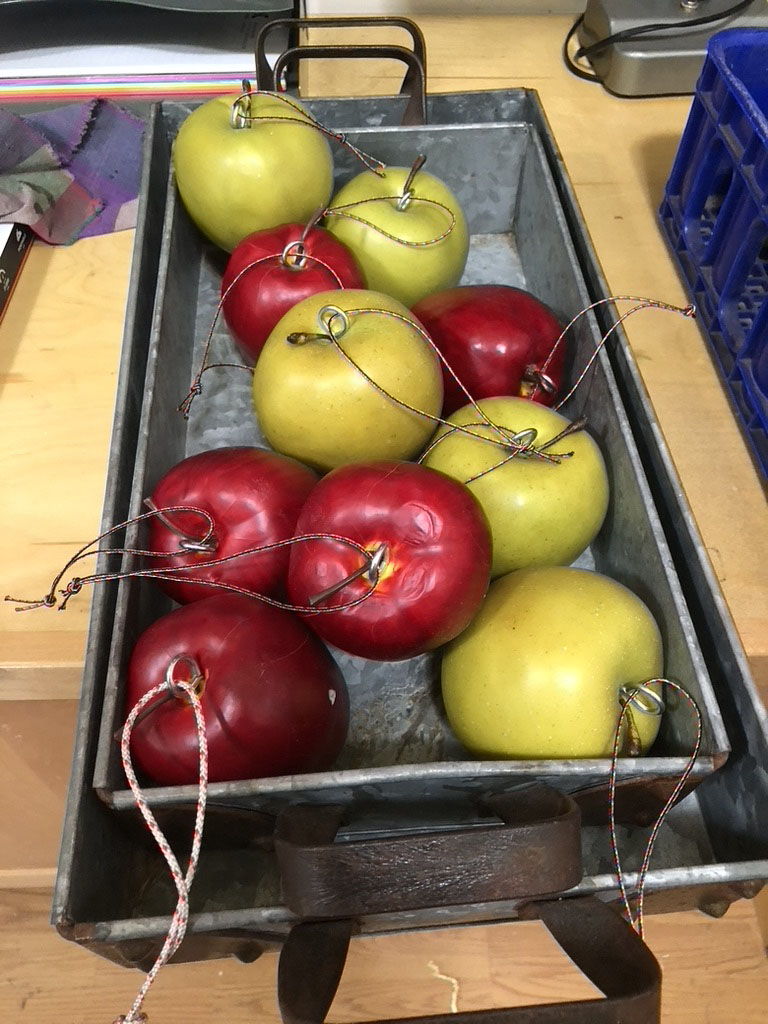

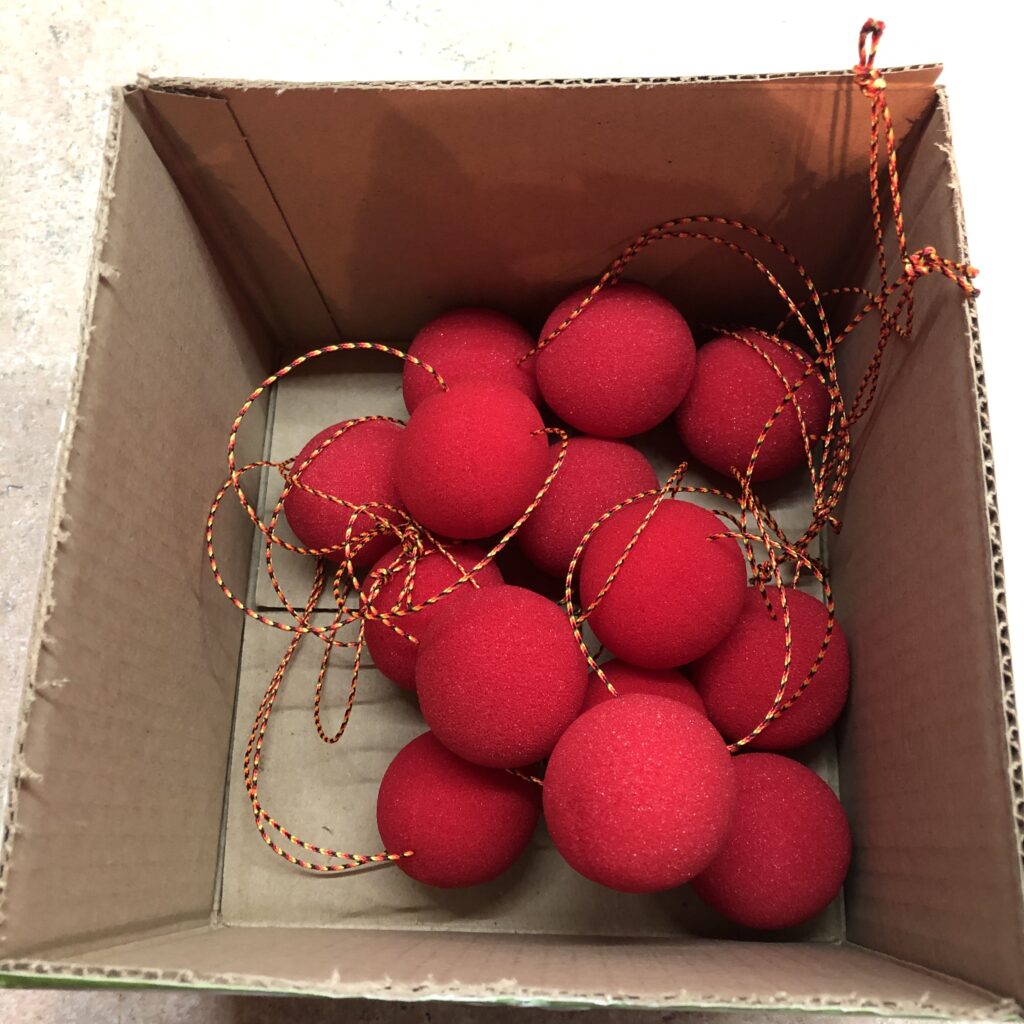
Yes, easier than it sounds. You can either spray them on the ground then brave the hanging and get them caught on your clothes and hair or hang them, then spray, ensuring some amount of errant Tanglefoot spray gets on your face. Without fail.
And by the end of the week, every doorknob in your house (and to each outbuilding) will be sticky. Also, your hair will have issues.
A system of my own devising, this has not worked yet and may not because the foam appears to have soaked in the Tanglefoot.
The next step would have been to string up some fake apples I scored at the Angels Over Sandpoint garage sale. Even more sophisticated lures.
But the fake apple method failed entirely. No moths got stuck to the foam balls, so I did not bother with the apples, cool as that project was.
Goal: KILL CATERPILLARS (LARVAE)
Method 3: Spray Cyd-X every 7-10 days after fruit has set
Once the fruit has set you want to kill the larvae that successfully hatched from last years’ cocoons.
For me, this meant using my trusty Kimo backpack sprayer filled with an aqueous solution of a pest control liquid worth its weight in gold, Cyd-X.

You use just one ounce for every application and the idea is the lighter the better.
Here are the specific instructions:
CROPS: Apple, pear, plum, prune, and walnut
Application rate: 1/2 to 3 fluid ounces per acre of tree
Mix CYD-X HP with water and apply as a spray to fruit and foliage. For best results, use water at or near neutral pH (7).
- Apply in sufficient water to thoroughly wet the tree canopy without excessive runoff.
- Select a spray volume appropriate to tree size and density of foliage: For small trees use 50-100 gallons of spray per acre. Larger trees with denser canopy may require 100-200 gallons per acre.
- Make at least 2 applications of CYD-X HP per codling moth larval generation.
- Target small larvae early in their life cycle and repeat as necessary to maintain control.
- CYD-X HP breaks down under direct exposure to sunlight, so reapply after 7-8 sunny days if codling moth are still flying and laying eggs.
- If using temperature models (heat unit accumulation measured in degree days) and pheromone trap catch to predict codling moth development, make the first spray against the first larval generation around 250-degree days after codling moth Biofix (first moth flight).
- If targeting the second generation, start at approximately 1100-1200 degree days after biofix. “No Biofix” models (using heat units only, with no trap catch information) are now used in some growing regions.
- If not using heat units to time sprays, apply CYD-X HP in the 1st and 2nd cover sprays against first generation larvae. For second generation, apply in the 4th and 5th cover sprays.
- Frequent applications at low rates may be more effective than one or two applications at high rate.
The liquid is brown and mildly stinky but not harmful to you and me. However, it is 100% lethal to codling moths.
Even more pleasing:
- The baculovaris particles in CYD-X HP are naturally encapsulated within a protein occlusion body (OB). In order to infect the codling moth larvae, these OBs must be ingested. Once they do, the digestive tract of the larvae will dissolve the outer coating of the OB and release the virus into the larval body. The virus then penetrates cells inside the gut and programs them to replicate the virus, which will continue to infect more and more cells and organs until it ultimately kills the larvae. When the host is dead, decomposition releases billions of new viral OBs.
- These OBs are then spread by rain, or gravity, or larval movement and will contaminate the area and attach to any larvae present. Once the larvae start feeding, those billions of OBs will enter the body of the larvae and the cycle begins again
I filled the 3-gallon tank two times and hit the Pink Lady and Transparent apples from top to bottom as thoroughly as possible. This meant using the orchard ladder with the fully loaded backpack.
(Yes, this is the same set-up as the nematodes but this time I sprayed the trees and not the ground).
Note: Three gallons of water is heavier than you think at 15 feet up in the treetops.
I sprayed every 7-10 days three times.
Disappointment, For Reals
But as I examined my apples, I saw that the little bastards had entered them though the blossom ends or ugly self-made dimples to feed on the seeds inside. What?? How could this be??
For a split second I thought about giving up, but I have come so far.
A Come to Jesus Moment
While mowing outside the orchard I saw evidence of codling moth caterpillars on the tip of one branch of the Pink Lady. Squealing to a halt, I ran in the orchard to discover this fresh hell.As the walls came crashing in, I will admit five minutes of hopelessness.
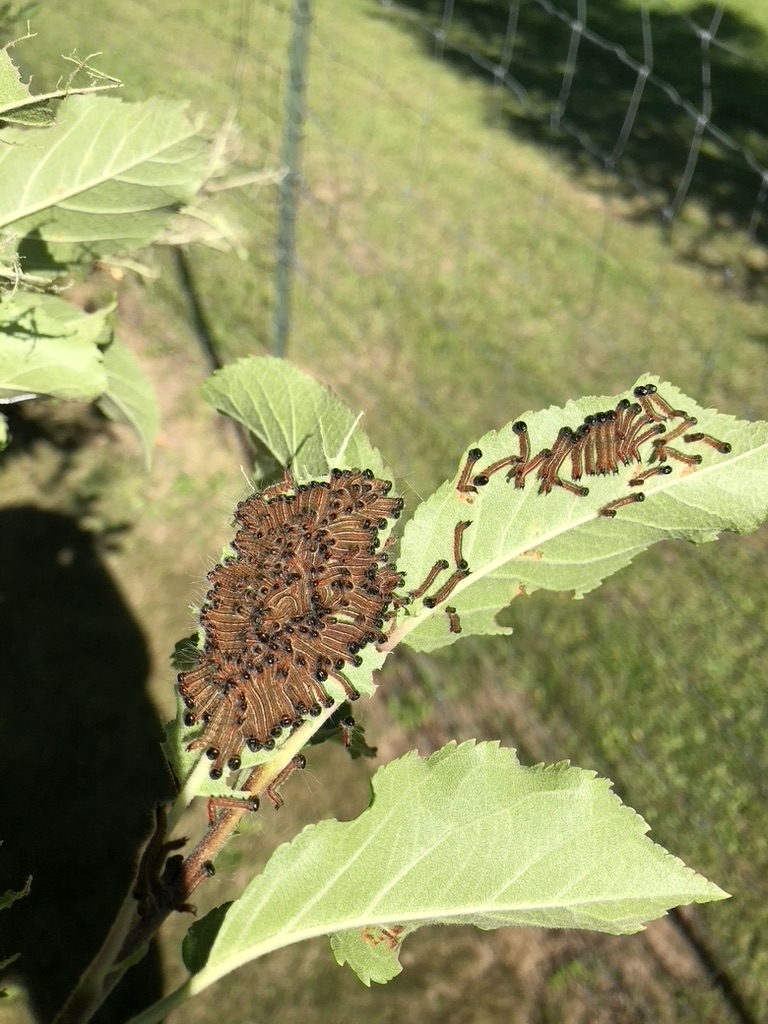
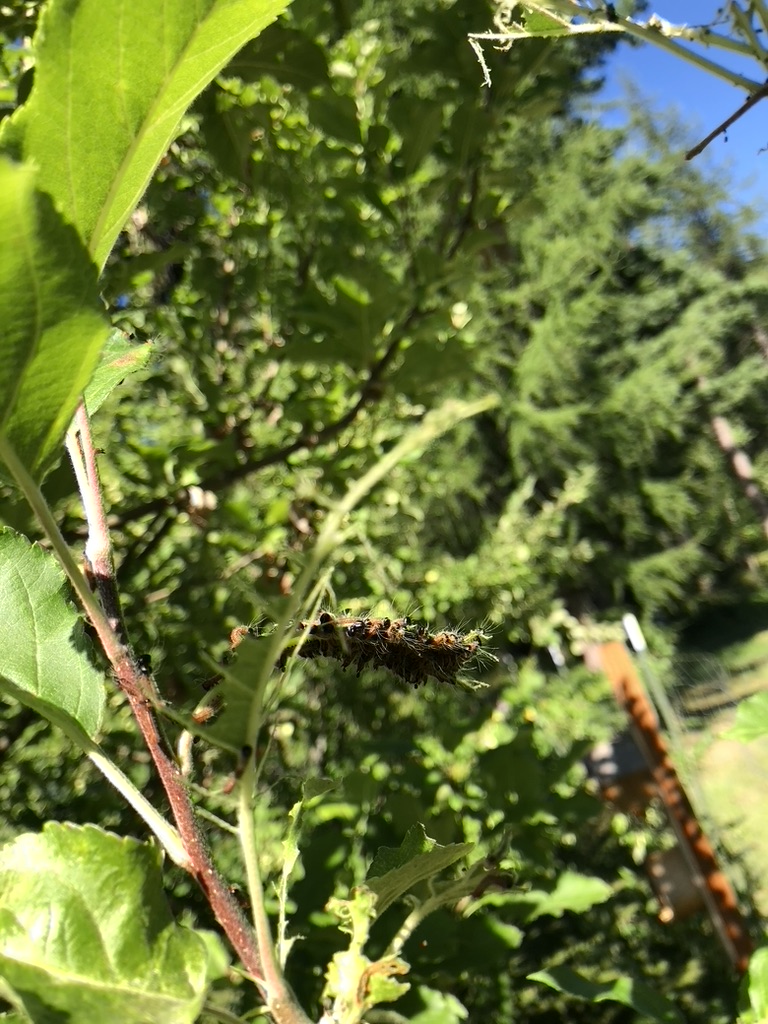

While mowing outside the orchard I saw evidence of codling moth caterpillars on the tip of one branch of the Pink Lady. Squealing to a halt, I ran in the orchard to discover this fresh hell.As the walls came crashing in, I will admit five minutes of hopelessness.

My expression says it all. So gross!
I scurried up the orchard ladder, black plastic trash bag in hand and nipped off that twig, with caterpillars trying to bail off it — using little filaments. God, they are like little evil magicians!
I tied it tight and left them to die.
WTFF?
I called Arbico and was at first upset but the customer service lady pointed out that the lack of flying adults in my traps indicates my nematode treatment killed a lot of them and that the larvae I am dealing with here were overwintered and can now be killed with Cyd-X.
I was only too happy to spray again, imagining them liquefying from the inside out.
At this time I have about 2 ounces of Cyd-X left and will spray the rest.
My plan is to keep on this and definitely repeat the nematode trick in spring.
In the meantime, I will cut around the grossness in the apples.
And consider whether that is the ultimate solution anyway.
“Strength and growth come only through continuous effort and struggle.”
Napoleon Hill

